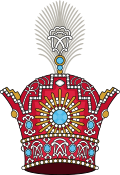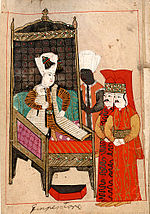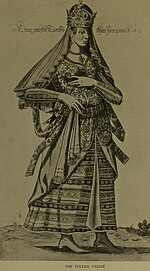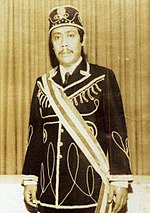Sultan
This articleneeds additional citations forverification.(June 2021) |

| Part ofa serieson |
| Imperial, royal, noble, gentry and chivalric ranksinWest,Central,South AsiaandNorth Africa |
|---|
 |
Sultan(/ˈsʌltən/;Arabic:سلطانsulṭān,pronounced[sʊlˈtˤɑːn,solˈtˤɑːn]) is apositionwith several historical meanings. Originally, it was an Arabicabstract nounmeaning "strength", "authority", "rulership", derived from theverbal nounسلطةsulṭah,meaning "authority" or "power". Later, it came to be used as the title of certain rulers who claimed almost full sovereignty (i.e., not having dependence on any higher ruler) without claiming the overallcaliphate,or to refer to a powerfulgovernorof a province within the caliphate. The adjectival form of the word is "sultanic",[1]and thestateand territories ruled by a sultan, as well as his office, are referred to as asultanate(سلطنةsalṭanah).[2][3]
The term is distinct from king (ملكmalik), though both refer to a sovereign ruler. The use of "sultan" is restricted to Muslim countries, where the title carries religious significance,[4][5]contrasting the more secularking,which is used in both Muslim and non-Muslim countries.
Brunei,MalaysiaandOmanare the only independent countries which retain the title "sultan" for their monarchs. In recent years, the title has been gradually replaced by "king" by contemporary hereditary rulers who wish to emphasize their secular authority under the rule of law. A notable example isMorocco,whose monarch changed his title from sultan to king in 1957.
History of the term
[edit]The word derives from the Arabic and Semitic rootsalaṭa"to be hard, strong". The nounsulṭāninitially designated a kind of moral authority or spiritual power (as opposed to political power), and it is used in this sense several times in theQur'an.[6]
In theearly Muslim world,ultimate power and authority was theoretically held by the caliph, who was considered the leader of the caliphate. The increasing political fragmentation of the Muslim world after the 8th century, however, challenged this consensus. Local governors with administrative authority held the title ofamīr(أمير,traditionally "commander" or "emir",later also" prince ") and were appointed by the caliph, but in the 9th century some of these becamede factoindependent rulers who founded their own dynasties, such as theAghlabidsandTulunids.[7]Towards the late 10th century, the term "sultan" begins to be used to denote an individual ruler with practically sovereign authority,[8]although the early evolution of the term is complicated and difficult to establish.[6]
The first major figure to clearly grant himself this title was theGhaznavidrulerMahmud(r. 998–1030 CE) who controlled an empire over present-dayAfghanistanand the surrounding region.[8][6]Soon after, theGreat Seljuksadopted this title after defeating the Ghaznavid Empire and taking control of an even larger territory which includedBaghdad,the capital of theAbbasid caliphs.The early Seljuk leaderTughril Beywas the first leader to adopt the epithet "sultan" on hiscoinage.[6]While the Seljuks acknowledged the caliphs in Baghdad formally as the universal leader of theMuslim community,their own political power clearly overshadowed the latter. This led to various Muslim scholars – notablyAl-JuwayniandAl-Ghazali– attempting to develop theoretical justifications for the political authority of the Seljuk sultans within the framework of the formal supreme authority of the recognized caliphs. In general, the theories maintained that all legitimate authority derived from the caliph, but that it was delegated to sovereign rulers whom the caliph recognized. Al-Ghazali, for example, argued that while the caliph was the guarantor of Islamic law (shari'a), coercive power was required to enforce the law in practice and the leader who exercised that power directly was the sultan.[9][8]
The position of sultan continued to grow in importance during the period of theCrusades,when leaders who held the title of "sultan" (such asSalah ad-Dinand theAyyubid dynasty) led the confrontation against theCrusader statesin theLevant.[6]Views about the office of the sultan further developed during the crisis that followed thedestruction of Baghdadby theMongolsin 1258, which eliminated the remnants of Abbasid political power. Henceforth, the surviving descendants of the Abbasid caliphs lived inCairounder the protection of theMamluksand were still nominally recognized by the latter. However, from this time on they effectively had no authority and were not universally recognized across the Sunni Muslim world.[9]As protectors of the line of the Abbasid caliphs, the Mamluks recognized themselves as sultans and the Muslim scholar Khalil al-Zahiri argued that only they could hold that title.[6]Nonetheless, in practice, many Muslim rulers of this period were now using the title as well. Mongol rulers (who had since converted to Islam) and other Turkish rulers were among those who did so.[6]
The position of sultan and caliph began to blend together in the 16th century when theOttoman Empireconquered the Mamluk Empire and became the indisputable leading Sunni Muslim power across most of theMiddle East,North Africa,andEastern Europe.The 16th-century Ottoman scholar and jurist,Ebüssuûd Mehmet Efendi,recognized theOttoman sultan(Suleiman the Magnificentat the time) as the caliph and universal leader of all Muslims.[9]This conflation of sultan and caliph became more clearly emphasized in the 19th century during the Ottoman Empire's territorial decline, when Ottoman authorities sought to cast the sultan as the leader of the entire Muslim community in the face of European (Christian)colonial expansion.[10]As part of this narrative, it was claimed that when SultanSelim Icaptured Cairo in 1517, the last descendant of the Abbasids in Cairo formally passed on the position of caliph to him.[10]This combination thus elevated the sultan's religious or spiritual authority, in addition to his formal political authority.[9][10]
During this later period, the title of sultan was still used outside the Ottoman Empire as well, as with the examples of theSomali aristocrats,Malay noblesand thesultans of Morocco(such as theAlaouite dynastyfounded in the 17th century).[6]It was, however, not used as a sovereign title byShi'aMuslim rulers. TheSafavid dynastyofIran,who controlled the largest Shi'a Muslim state of this era, mainly used thePersiantitleShah,a tradition which continued under subsequent dynasties. The termsultan,by contrast, was mainly given to provincial governors within their realm.[6]
Feminine forms
[edit]A feminine form ofsultan,used by Westerners, isSultanaorSultanahand this title has been used legally for some (not all)Muslim womenmonarchs and sultan's mothers and chief consorts. However,TurkishandOttoman Turkishalso usessultanfor imperial lady, asTurkish grammaruses the same words for both women and men (such asHurrem Sultanand Sultan Suleiman Han (Suleiman the Magnificent)). The female leaders inMuslim historyare correctly known as "sultanas". However, the wife of the sultan in theSultanate of Suluis styled as the "panguian" while the sultan's chief wife in many sultanates ofIndonesiaandMalaysiaare known as "permaisuri", "Tunku Ampuan", "Raja Perempuan", or "Tengku Ampuan". Thequeen consortinBruneiespecially is known asRaja Isteriwith the title ofPengiran Anaksuffixed, should the queen consort also be a royal princess.
Compound ruler titles
[edit]
These are generally secondary titles, either lofty 'poetry' or with a message, e.g.:
- Mani Sultan–Manney Sultan(meaning the "Pearl of Rulers" or "Honoured Monarch" ) – a subsidiary title, part of the full style of theMaharajaofTravancore
- Sultan of Sultans– the sultanic equivalent of the styleKing of Kings
- Certain secondary titles have a devout Islamic connotation; e.g.,Sultan ul-Mujahidinas champion ofjihad(to strive and to struggle in the name of Allah).
- Sultanic Highness– a rare, hybrid western-Islamic honorific style exclusively used by the son, daughter-in-law and daughters of SultanHussein Kamel of Egypt(aBritish protectoratesince 1914), who bore it with their primary titles ofPrince(Amir;Turkish:Prens) orPrincess,after 11 October 1917. They enjoyed these titles for life, even after the Royal Rescript regulating the styles and titles of the Royal House following Egypt'sindependence in 1922,when the sons and daughters of the newly styled king (malikMisr,considered a promotion) were granted the titleSahib(at) us-Sumuw al-Malaki,orRoyal Highness.
- Sultan-ul-Qaum– a title meaning King of the Nation, given to 18th-centurySikhleaderJassa Singh Ahluwaliaby his supporters
Princely and aristocratic titles
[edit]
By the beginning of the 16th century, the title sultan was carried by both men and women of the Ottoman dynasty and was replacing other titles by which prominent members of the imperial family had been known (notablykhatunfor women andbeyfor men). This usage underlines the Ottoman conception of sovereign power as family prerogative.
Western tradition knows the Ottoman ruler as "sultan", but Ottomans themselves used "padişah" (emperor) or "hünkar" to refer to their ruler. The emperor's formal title consisted of "sultan" together with "khan" (for example, Sultan Suleiman Khan). In formal address, the sultan's children were also entitled "sultan", with imperial princes (Şehzade) carrying the title before their given name, and imperial princesses carrying it after. For example:Şehzade Sultan MehmedandMihrimah Sultan,son and daughter of Suleiman the Magnificent. Like imperial princesses, the living mother and main consort of the reigning sultan also carried the title after their given names, for example:Hafsa Sultan,Suleiman's mother and firstvalide sultan,andHürrem Sultan,Suleiman's chief consort and firsthaseki sultan.The evolving usage of this title reflected power shifts among imperial women, especially between theSultanate of Women,as the position of main consort eroded over the course of the 17th century, with the main consort losing the title of "sultan", which was replaced by "kadin", a title related to the earlier "khatun". Henceforth, the mother of the reigning sultan was the only person of non imperial blood to carry the title "sultan".[11]
InKazakh Khanatea Sultan was a lord from the ruling dynasty (a direct descendants ofGenghis Khan) elected by clans, i.e. a kind of prince. The best of sultans was elected askhanby people atKurultai.[citation needed]
Military rank
[edit]In a number of post-caliphal states underMongolorTurkicrule, there was afeudaltype of military hierarchy. These administrations were often decimal (mainly in larger empires), using originally princely titles such askhan,malik,amiras mere rank denominations.
In thePersian empire,the rank of sultan was roughly equivalent to that of a modern-daycaptainin the West; socially in the fifth-rank class, styled 'Ali Jah.
Former sultans and sultanates
[edit]Sultanates in the Balkans, Anatolia and Central Asia
[edit]- Ghaznavid Empire;its ruler,Mahmud of Ghazni,was the firstMuslimsovereign to be known as sultan.
- Great Seljuk Empire
- Sultanate of Rum
- Ottoman Empire
- Timurid Empire
- Kazakh Khanate
Caucasus
[edit]- Elisu Sultanateand a few others. A Sultan ranked below a Khan.
West Asia and North Africa
[edit]- inIran:
- Sultans ofBaneh(InKurdistan,members of the Ekhtiyar al-Din family governed Baneh as Sultans defending against the Ottoman frontier)[12]
- Ghaznavid Empire
- inSyria:

- inJordan:
- in present-dayYemen,various small sultanates of the defunctAden ProtectorateandSouth Arabia:
- Audhali,Fadhli,Haushabi,Kathiri,Lahej,Lower Aulaqi,Lower Yafa,Mahra,Qu'aiti,Subeihi,Upper Aulaqi,Upper Yafaand theWahidisultanates
- in present-daySaudi Arabia:
- Oman–Sultan of Oman(authentically referred to asHami), on the southern coast of the Arabian peninsula, still an independent sultanate, since 1744 (assumed the formal title of Sultan in 1861)
- inAlgeria:Sultanate of Tuggurt,Sultans of Tlemcen
- inEgypt:

- inMorocco,untilMohammed Vchanged the style toMalik(king) on August 14, 1957, maintaining the subsidiary styleAmir al-Mu'minin(Commander of the Faithful)
- inSudan:
- Darfur
- Dar al-Masalit
- Dar Qimr
- Funj SultanateofSinnar(Sennar)
- Kordofan
- inIraq:
- Abbasid Caliphate(autonomous provinces)
- Ottoman Empire
Horn of Africa
[edit]
- Ajuran Sultanate,in southern Somalia and eastern Ethiopia
- Adal Sultanate,in westernSomaliland,southernDjibouti,and theSomali,HarariandAfarregions ofEthiopia
- Isaaq Sultanate,in Somaliland and theSomali regionof Ethiopia
- Habr Yunis Sultanate,in Somaliland andSomali regionof Ethiopia
- Majeerteen Sultanate(Migiurtinia), in northern Somalia
- Warsangali Sultanate,in northern Somalia
- Sultanate of the Geledi,in southern Somalia
- Sultanate of Aussa,in northeastern Ethiopia
- Sultanate of Harar,in eastern Ethiopia
- Jarso Sultanate
- Sultanate of Hobyo,in central Somalia
- Sultanate of Ifat,in Somaliland, Djibouti and eastern Ethiopia
- Sultanate of Mogadishu,in south-central Somalia
- Sultanate of Showa,in central Ethiopia
- Bimaal Sultanate,in south eastern Somalia centred inMerka
Southeast Africa and Indian Ocean
[edit]- Angoche Sultanate,on theMozambiquancoast (also several neighbouring sheikdoms)
- varioussultans on the Comoros;however on theComoros,the normally used styles were alternative native titles, includingMfalme,PhanyorJambéand the 'hegemonic' titleSultani tibe
- the Maore (or Mawuti) sultanate onMayotte(separated from the Comoros)
Maliki
[edit]Apparently derived from the Arabicmalik,this was the alternative native style of the sultans of theKilwa SultanateinTanganyika(presently the continental part of Tanzania).
Swahili Coast
[edit]
- Sultanate of Zanzibar:two incumbents (from the Omani dynasty) since the de facto separation from Oman in 1806, the last assumed the title Sultan in 1861 at the formal separation under British auspices;[citation needed]since 1964 union with Tanganyika (part ofTanzania)
Mfalumeis the(Ki)Swahilititle of various native Muslim rulers, generally rendered in Arabic and in western languages as Sultan:
- inKenya:
- Pateon part ofPate island(capital also named Pate), in theLamu Archipelago
- Wituland,became a German, thenBritish protectorate
- inTanganyika(presently part ofTanzania): of Hadimu, on the island of that name; also styledJembe
Sultani
[edit]This was the native ruler's title in the Tanzanian state of Uhehe.
West and Central Africa
[edit]- InCameroon:
- Bamoun(Bamun, 17th century, founded uniting 17 chieftaincies) 1918 becomes a sultanate, but in 1923 re-divided into the 17 original chieftaincies.
- Bibemi,founded in 1770 - initially styledlamido
- MandaraSultanate, since 1715 (replacingWandalakingdom); 1902 Part of Cameroon
- Rey BoubaSultanate founded 1804
- in theCentral African Republic:
- Bangassoucreatedc. 1878;14 June 1890 underCongo Free Stateprotectorate,1894 under French protectorate; 1917 Sultanate suppressed by the French.
- Dar al-Kuti - French protectorate since December 12, 1897
- Rafaic. 1875Sultanate, April 8, 1892, under Congo Free State protectorate, March 31, 1909, under French protectorate; 1939 Sultanate suppressed
- Zemioc. 1872established; December 11, 1894, under Congo Free State protectorate, April 12, 1909, under French protectorate; 1923 Sultanate suppressed
- inChad:
- inNiger:Arabicalternative title of the following autochthonous rulers:
- theAmenokalof theAïrconfederation ofTuareg
- the Sarkin Damagaram since the 1731 founding of theSultanate of Damagaram(Zinder)
- inNigeriamost monarchies previously had native titles, but when most in the north converted to Islam, Muslim titles were adopted, such asemirand sometimessultan.
- inBorno(alongside the native titleMai)
- since 1817 inSokoto,the suzerain (also styledAmir al-Mu´mininand Sarkin Musulmi) of allFulbe jihad statesand premier traditional Muslim leader in theSahel(according to some once a caliph)
South Asia
[edit]- Afghan Kingdom:Sultan had a different meaning. It was a high title of honour, superior to Amir and Sardar, but ranking below Shah.[citation needed]
- Bahmani Sultanate:Bahmani Shahs
- Sultanate of Bengal:Ilyas Shahi,Ganesha,Habshi,Hussain Shahi,Muhammad Shah andKarranis
- Sultanates of the Deccan:
- Sultanate of Delhi:Mamluks,Khiljis,Tughlaqs,SayyidsandLodis
- Sultanate of Gujarat:Muzaffarids
- Sultanate of Jaunpur:Sharqi dynasty
- Sultanate of Kandesh:Faruqi dynasty
- Sultanate of Malwa:three dynasties
- Sultanate of Madurai
- Sultanate of Laccadive and Cannanore:Arakkal Kingdom
- Sultanate of Kashmir:ShahmiridsandChaks
- Sultanate of Maldives
Southeast and East Asia
[edit]



InIndonesia(formerly in theDutch East Indies):
- OnKalimantan
- Sultanate of Banjar
- Sultanate of Berau
- Sultanate of Bulungan
- Sultanate of Gunung Tabur
- Sultanate of Kubu
- Kutai Kartanegara Sultanate
- Sultanate of Mempawah
- Sultanate of Paser
- Sultanate of Pontianak
- Sultanate of Sambaliung
- Sultanate of Sambas
- OnSulawesi
- Sultanate of Buton
- Sultanate of Bone
- Sultanate of Gowa
- Sultanate of Luwu
- Sultanate of Soppeng
- Sultanate of Wajoq
- OnJava
- Sultanate of Banten
- Sultanate of Cirebon- the rulers in three of the four palaces (kraton), from which dividedCirebonwas ruled:Kraton Kasepuhan,Kraton Kanomanand Kraton Kacirebonan (only in Kraton Kaprabonan was the ruler's title Panembahan)
- Sultanate of Demak
- Sultanate of Pajang
- Sumedang Larang Sultanate
- Sultanate of Mataram(was divided into two kingdoms: the Sultanate of Yogyakarta and Sunanan Surakarta)
- Sultanate of Yogyakarta
- Sunanate of Surakarta(susuhunan,a high-ranked monarch, equivalent to emperor)
- In theMaluku Islands
- Sultanate of Iha(Saparua)
- Sultanate of Honimoa/ Siri Sori (Saparua)
- Sultanate of Huamual(West Seram)
- Sultanate of Negeri Soya(Ambon)
- Sultanate of Tanah Hitu(Ambon)
- Sultanate of Ternate
- Sultanate of Tidore
- Sultanate of Bacan
- Sultanate of Jailolo
- Sultanate of Loloda(North Halmahera)
- In theNusa Tenggara
- Bima Sultanateon Sumbawa island
- In theRiau Archipelago:Sultanate of Riau-Linggaby secession in 1818 under the expelled sultan ofJohore(on Malaya) Sultan Abdul Rahman Muadzam Syah ibni al-Marhum Sultan Mahmud
- InSumatra
- Aceh Sultanate(full styleSultan Berdaulat Zillullah fil-Alam)
- Sultanate of Asahan
- Awak Sungai, established 17th century at the split in four ofMinangkabau,in 1816 extinguished by Netherlands East Indies colonial government
- Sultanate of Deli
- Sultanate of Indragiri
- Sultanate of Langkat(previous style Raja)
- Palembang Sultanate(Darussalam), also holding the higher title ofSusuhunan
- Sultanate of Pagaruyung
- Sultanate of Perleuak
- Riau-Lingga Sultanate
- Samudera Pasai Sultanate
- Sultanate of Serdang
- Sultanate of Siak
InMalaysia:
- InPeninsular Malaysia,where all seven of the country's present sultanates are located:
- Furthermore, the ruler ofLuak Jelebu,one of the constitutive states of theNegeri Sembilanconfederation, had the style Sultan in addition to his principal titleUndang Luak Jelebu.
- Sultanate of Malacca
- Sultanate of Sarawak
InBrunei:
- Sultan of Brunei,Brunei (on Borneo island)
InChina:
- Dali, Yunnan,capital of the short-livedPanthay Rebellion
- Furthermore, theQa´id Jami al-Muslimin(Leader of the Community of Muslims) ofPingnan Guo( "Pacified South State", a major Islamic rebellious polity in western Yunnan province) is usually referred to in foreign sources as Sultan.
- Ili Sultanate
In thePhilippines:
- Sultanate of Buayan
- Sultanate of Maguindanao
- Sultanate of Sulu(Sulu, Basilan, Palawan and Tawi-Tawi islands and part of eastern Sabah on North Borneo)
InThailand:
Current sultans
[edit]Sultans of sovereign states
 SultanHassanal Bolkiah,Sultan and Yang di-Pertuan Negara ofNation of Brunei, the Abode of Peace
SultanHassanal Bolkiah,Sultan and Yang di-Pertuan Negara ofNation of Brunei, the Abode of Peace SultanHaitham bin Tariq,Sultan of theSultanate of Oman
SultanHaitham bin Tariq,Sultan of theSultanate of Oman
Sultans in Federal Monarchies
 SultanIbrahim Ismail,Sultan and Yang di-Pertuan ofMalaysian State of Johor, The Abode of Dignityand its occupied territories
SultanIbrahim Ismail,Sultan and Yang di-Pertuan ofMalaysian State of Johor, The Abode of Dignityand its occupied territories SultanSallehuddin,Sultan and Yang-di Pertuan ofMalaysian State of Kedah, the Abode of Safety
SultanSallehuddin,Sultan and Yang-di Pertuan ofMalaysian State of Kedah, the Abode of Safety Sultan Muhammad V,Al-Sultan and Yang di-Pertuan ofMalaysian State of Kelantan, the Abode of Blissand its dependencies
Sultan Muhammad V,Al-Sultan and Yang di-Pertuan ofMalaysian State of Kelantan, the Abode of Blissand its dependencies Al-SultanAbdullah Ri'ayatuddin,Sultan and Ruler ofMalaysian State of Pahang, the Abode of Tranquility
Al-SultanAbdullah Ri'ayatuddin,Sultan and Ruler ofMalaysian State of Pahang, the Abode of Tranquility SultanNazrin Shah,Sultan, Yang di-Pertuan and the Ruler ofMalaysian State of Perak, the Abode of Graceand its dependencies
SultanNazrin Shah,Sultan, Yang di-Pertuan and the Ruler ofMalaysian State of Perak, the Abode of Graceand its dependencies SultanSharafuddin Idris Shah,Sultan and Yang di-Pertuan ofMalaysian State of Selangor, the Abode of Sincerity
SultanSharafuddin Idris Shah,Sultan and Yang di-Pertuan ofMalaysian State of Selangor, the Abode of Sincerity SultanMizan Zainal Abidin,Sultan and Yang di-Pertuan ofMalaysian State of Terengganu, the Abode of Faith
SultanMizan Zainal Abidin,Sultan and Yang di-Pertuan ofMalaysian State of Terengganu, the Abode of Faith
Sultan with power within Republic
 Sri SultanHamengkubuwono X,Sultan andGovernorofIndonesian Special Region of Yogyakarta
Sri SultanHamengkubuwono X,Sultan andGovernorofIndonesian Special Region of Yogyakarta
See also
[edit]References
[edit]- ^"sultan".Dictionary.com.Archivedfrom the original on 2023-02-08.Retrieved2023-02-08.
- ^"Sultanate".Merriam-Webster.com Dictionary.Archivedfrom the original on 2022-06-22.Retrieved2022-06-22.
- ^"Sultanate".Britannica Dictionary.Archivedfrom the original on 2022-06-22.Retrieved2022-06-22.
- ^Montgomery, James Edward (2004).ʻAbbasid Studies: Occasional Papers of the School of ʻAbbasid Studies, Cambridge, 6–10 July 2002.Peeters Publishers. p. 83.ISBN978-90-429-1433-9.Archivedfrom the original on 27 January 2024.Retrieved16 January2018.
- ^Riad Aziz Kassis (1999).The Book of Proverbs and Arabic Proverbial Works.Brill. p. 65.ISBN90-04-11305-3.Archivedfrom the original on 2024-01-27.Retrieved2018-01-16.
- ^abcdefghiKramers, J.H.; Bosworth, C.E.; Schumann, O.; Kane, Ousmane (2012). "Sulṭān". In Bearman, P.; Bianquis, Th.; Bosworth, C.E.; van Donzel, E.; Heinrichs, W.P. (eds.).Encyclopaedia of Islam, Second Edition.Brill.
- ^Duri, A.A. (2012). "Amīr". In Bearman, P.; Bianquis, Th.; Bosworth, C.E.; van Donzel, E.; Heinrichs, W.P. (eds.).Encyclopaedia of Islam, Second Edition.Brill.
- ^abcEsposito, John L., ed. (2003). "Sultan".The Islamic World: Past and Present.Oxford University Press.
- ^abcdTuran, Ebru (2009). "Sultan". In Esposito, John L. (ed.).The Oxford Encyclopedia of the Islamic World.Oxford University Press.
- ^abcFinkel, Caroline (2012).Osman's Dream: The Story of the Ottoman Empire 1300–1923.John Murray Press.ISBN978-1848547858.
- ^Peirce, Leslie P. (1993).The Imperial Harem: Women and Sovereignty in the Ottoman Empire.New York: Oxford University Press.ISBN0-19-507673-7.
- ^Mardūḵ, 'A. (December 15, 1988)."BĀNA".Encyclopaedia Iranica.
